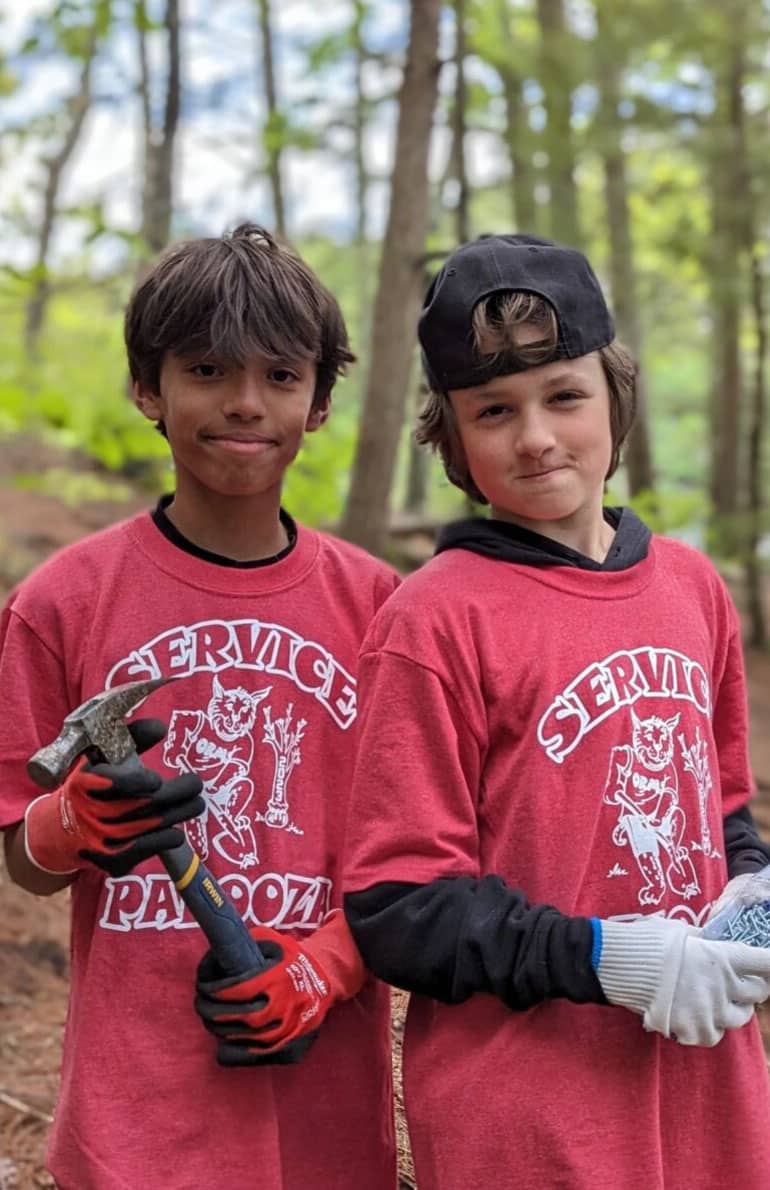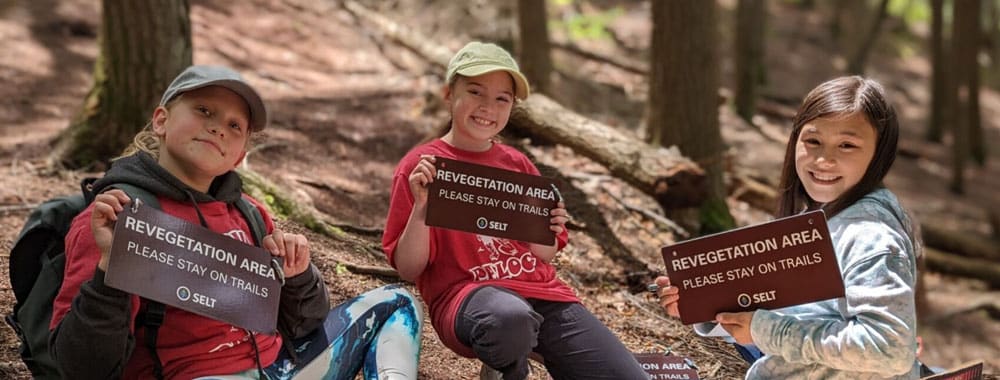Written and photographed by David Johnson
For a group of nature-defending, power-tool-curious fifth graders, getting outside and using their hands to benefit the living landscape of Stonehouse Forest is as great a school day as you could ask for.
There is activity up ahead. Faint voices ring out from the far reaches of Stonehouse Forest in Barrington. As you navigate through the foliage, those voices intermingle with other sounds: whirring, banging, clanging – the time-tested soundtrack to good old-fashioned manual labor.
The site of this cacophony is the recently constructed “Boulder Trail,” which connects the Stonehouse Pond kiosk to the iconic swimming boulder that sits on the shore of Stonehouse Pond and has long been a go-to spot for epic cannonballs.
Today, the trail is buzzing. Volunteers zigzag about, hauling branches and hanging signs, driving nails and drilling holes. But it’s not the usual crew working on the land. Not corporate volunteers, or local service organizations, or even SELT’s skilled team of volunteer land stewards.
Nope, today, it’s fifth graders – and they’re crushing it.
Dianne Pelletier, a fifth-grade teacher at Oyster River Middle School and one of the leaders for today’s expedition.
“The entire Oyster River Middle School of over 600 students is participating in community service today. Our team chose to come here to Stonehouse Pond to help protect this beautiful area.”
The volunteer day represents the culmination of a unique education project the class had undertaken; the “Trout in the Classroom” program gives students the opportunity to raise their own trout in a class setting, then release them into a nearby body of water. (The program is sponsored by SELT conservation and stewardship partners Trout Unlimited and New Hampshire Fish and Game Department).

“We’re here to clean up the trails to help make the pond healthier for the trout we raised,” said Caroline, an Oyster River fifth grader.
Following the trout release, the Oyster River crew segued into part 2 of their outdoor experience: hard work! And judging by the number of grins, the high-octane activity, the eagerness to try out new tools, and the rapt attention paid toward Yohann Hanley, SELT’s Trails and Community Engagement Manager, some dirt-under-the-fingernails is precisely what this group was all about.
And the task at hand?
“We are working on creating a revegetation area around the end of the dam at the Fish and Game boat launch.” Yohann says. “People have been coming across the dam to get to the swimming area and the foot traffic has stripped the understory of the forest behind us.”
Which is not what you want. The disappearance of the vegetation and lower forest structure that makes up the understory opens the door for erosion, which degrades the shoreline area over time, keeps new shoreline plants from growing, and exposes tree roots and degrades/compacts soil.
“This is a popular area with each person’s footsteps having an impact,” said Chad Fierros, SELT’s Forest and Wildlife Habitat Manager. “It’s difficult to keep your foot from sliding at least once when walking on those slopes and each time that happens, it sloughs away topsoil, a crucial part of the forest that takes many decades to re-accumulate.”
The Boulder Trail not only makes access direct and more convenient (and separates swim traffic from the nearby fly-fishing/boating area owned and managed by NH Fish & Game), but it also reduces impact on the surrounding, sensitive habitat.
So, the Oyster River team is hanging signs and roping off sensitive habitats to guide the users where they need to go.
“We’re putting big sticks and smaller sticks down over there so people won’t walk on that part anymore and the plants can grow back,” says Oyster River fifth-grader Finnian.
Marking the new swimmers’ trail is their primary duty, as the team has fanned out along the length of the path to install all the necessary directions to get users from Point A to Point Boulder.
You know what that means: power tools.
Truly – the clarion call of torque knows no age restrictions and Diane’s detachment of eager middle schoolers were vying for the opportunity to fire up one of the DeWalts and go to town.
“The academics we have been talking about in the classroom now have their practical application here,” Diane says. “The kids can come out here and really have hands-on experiences of why learning all those science concepts is important. And for the community service part, this opportunity develops
leadership skills and empowers the students to want to do good in the places where they live. Plus, it’s a really great way to spend a school day.”
Finnian puts it this way: “It beats math.”

